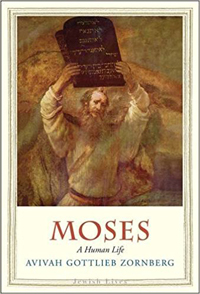 Avivah Gottlieb Zornberg, Moses: A Human Life (New Haven: Yale, 2016), 223pp.
Avivah Gottlieb Zornberg, Moses: A Human Life (New Haven: Yale, 2016), 223pp.
This short biography is one of the titles in Yale University Press's "Jewish Lives" series of "interpretive biographies" of Jewish figures in literature, religion, philosophy, politics, culture, economics, art, and the sciences. About thirty titles are already published, with about the same number still forthcoming.
The story of Moses unfolds during the Egyptian genocide. We read that "all the Egyptians" were ordered to throw "every Hebrew boy" into the Nile River (1:22). Moses survived the infanticide, and his own faults and fears, because of the courage and compassion of seven women who are specifically mentioned in his birth narrative.
The mid-wives Shiphrah and Puah were two ordinary women who performed extraordinary acts of faith. Moses's biological mother also resisted the genocide when she "hid him for three months." Moses's adoptive mother discovered the floating basket — she's the daughter of pharaoh and an Egyptian princess. She was accompanied by her women "attendants" and a "slave girl" who retrieved the baby Moses from the Nile. Miriam, the sister of Moses, "stood at a distance to see what would happen to him." She inserted herself into the story quite cleverly by suggesting to the princess that she obtain a Hebrew woman to nurse the crying baby. As an adult, Moses married Zipporah of Midian.
Moses thus grew up with an ambiguous triple identity. He was a Hebrew born into "the house of Levi," he was raised by his adoptive mother as a prince at the center of Egyptian political power, and then he married a foreign wife.
In the "far side of the desert" at Mt. Horeb, God called Moses to return to Egypt, the land of Israel's genocide, to mediate between God and his people, and between God and pharaoh. He appeared to Moses "in flames of fire from within a bush." His call was an impossible burden, fraught with ambiguities.
When God called him, Moses responded: "Here am I!" But later he wondered, "Who am I?" God assured him that "the people will listen." But Moses worried, "they won't listen." So, he was full of ambivalence, inhibitions, fears, and doubts, and rightly so. As Zornberg puts it, "there's a certain kind of reticence, or circumspection, that halts the true prophet, faced with the inscrutable God, whose revelation must be narrowed into what can be said."
Nonetheless, God insisted: "I am sending you to pharaoh to bring my people the Israelites out of Egypt." And when Moses doubted his deepest self, God assured him, "I will be with you." Such is the paradox and burden of prophecy, observed Martin Buber: "It is laid upon the stammering to bring the voice of Heaven to Earth."
Zornberg's interpretive methodology will strike most of us Christian readers as quite different, and for that very reason her book is well worth reading. She incorporates a broad and diverse number of sources — psychoanalysis (Freud), midrashic texts from the third to the tenth centuries, classic commentators, modern literature (Dickens, Kafka), poetry (Eliot), philosophers (Ricoeur, Buber, Nietzsche), and even painters (William Turner, Impressionism).
Perhaps this is fitting, for as the dust jacket blurb of this book puts it, "no figure looms larger in Jewish culture than Moses, and few have stories that are more enigmatic or compelling." In Zornberg's re-telling, Moses speaks today, 3300 years after he lived.


